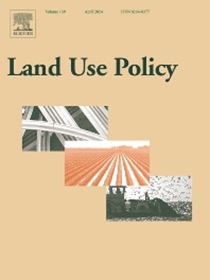A green infrastructure planning approach for enhanced flood control and resilience in urban areas
IF 6
1区 社会学
Q1 ENVIRONMENTAL STUDIES
引用次数: 0
Abstract
Urban flooding presents a growing challenge in metropolitan areas due to climate change and increasing impervious surfaces. This research proposes a Green Infrastructure (GI) planning approach to enhance flood control and resilience in the flood-prone Yeoksam-dong region of Gangnam, Seoul, South Korea. A mixed-method approach was employed, incorporating both residents’ preferences and hydrological simulations using the Stormwater Management Model (SWMM) to assess the effectiveness of various GI controls. Key GI co-benefits were identified through importance–performance analysis (IPA) and fuzzy weight rankings. Based on these, three GI scenarios were developed and evaluated for their flood mitigation potential. Scenario 1 (infiltration trench, rain garden, and rain barrel) emerged as the most effective, reducing surface runoff by 18.56 % and achieving the best cost-benefit ratio of 1.01 over a 10-year period. Scenario 2 (bio-retention, pervious pavement, and green roof), while less effective in terms of flood mitigation, may still offer ecological and social co-benefits. The study also conducted a sensitivity analysis, which confirmed Scenario 1’s robustness across various levels of imperviousness, making it a highly adaptable solution for urban settings. This research highlights the importance of community engagement in GI planning and demonstrates how integrating hydrological performance with socioeconomic benefits can enhance urban resilience. By aligning with the 4Rs of resilience; robustness, redundancy, resourcefulness, and rapidity, this study provides actionable insights for policymakers and urban planners seeking cost-effective, scalable solutions for flood-prone areas. The findings underscore the value of multifunctional GI controls in not only reducing flood risks but also promoting long-term sustainability and community well-being.
一种绿色基础设施规划方法,用于增强城市地区的防洪和抗洪能力
由于气候变化和越来越多的不透水表面,城市洪水在大都市地区提出了越来越大的挑战。本研究提出了一种绿色基础设施(GI)规划方法,以加强韩国首尔江南区易发洪水的驿三洞地区的防洪和抗洪能力。采用混合方法,结合居民的偏好和使用雨水管理模型(SWMM)的水文模拟来评估各种GI控制的有效性。通过重要性-绩效分析(IPA)和模糊权重排序确定了关键的GI协同效益。在此基础上,开发了三种地理特征情景,并对其洪水缓解潜力进行了评估。方案1(入渗沟、雨园和雨桶)效果最佳,减少地表径流18.56 %,10年的最佳成本效益比为1.01。方案2(生物保留、透水路面和绿色屋顶)虽然在缓解洪水方面效果较差,但仍可能提供生态和社会的协同效益。该研究还进行了敏感性分析,证实了方案1在不同级别的不透水性中的稳健性,使其成为城市环境中高度适应性的解决方案。本研究强调了社区参与地理标志规划的重要性,并展示了如何将水文性能与社会经济效益相结合,以增强城市韧性。通过与韧性的4r保持一致;该研究的稳健性、冗余性、智谋性和快速性为政策制定者和城市规划者在洪水易发地区寻求具有成本效益、可扩展的解决方案提供了可行的见解。研究结果强调了多功能GI控制的价值,不仅可以减少洪水风险,还可以促进长期可持续性和社区福祉。
本文章由计算机程序翻译,如有差异,请以英文原文为准。
求助全文
约1分钟内获得全文
求助全文
来源期刊

Land Use Policy
ENVIRONMENTAL STUDIES-
CiteScore
13.70
自引率
8.50%
发文量
553
期刊介绍:
Land Use Policy is an international and interdisciplinary journal concerned with the social, economic, political, legal, physical and planning aspects of urban and rural land use.
Land Use Policy examines issues in geography, agriculture, forestry, irrigation, environmental conservation, housing, urban development and transport in both developed and developing countries through major refereed articles and shorter viewpoint pieces.
 求助内容:
求助内容: 应助结果提醒方式:
应助结果提醒方式:


